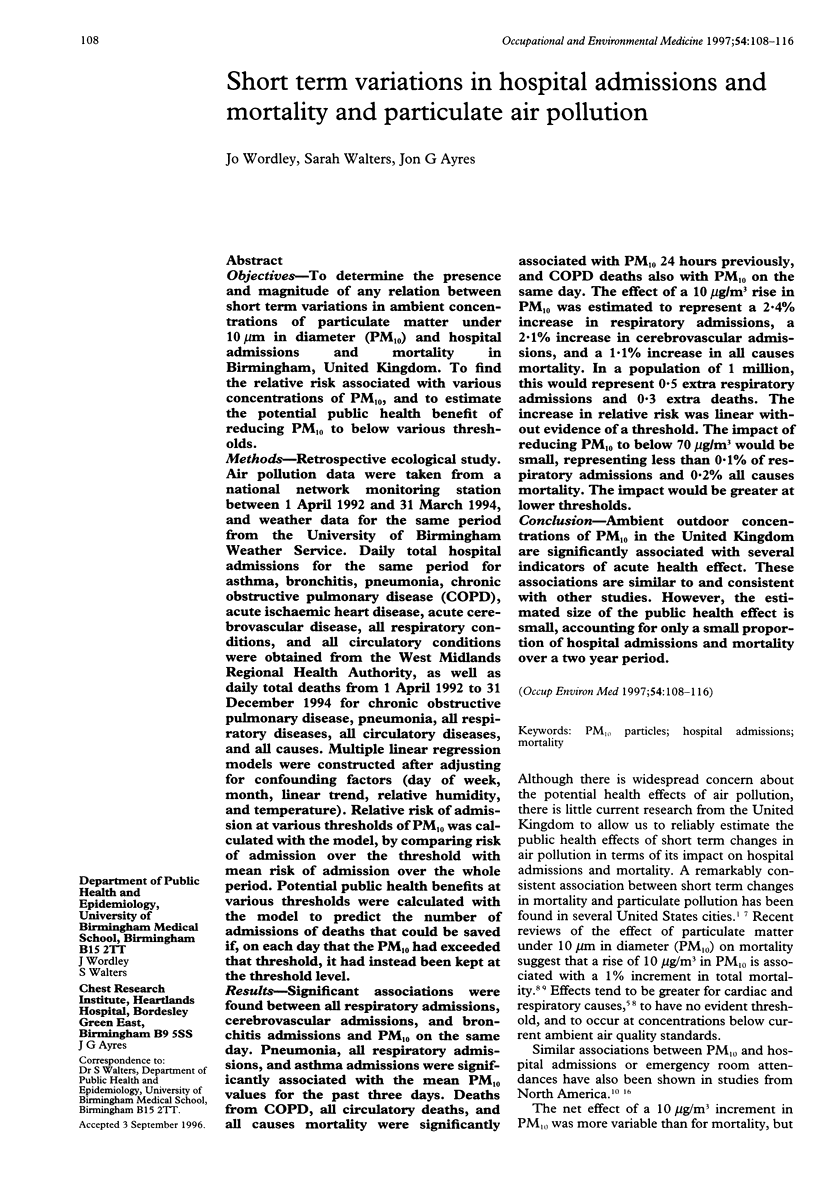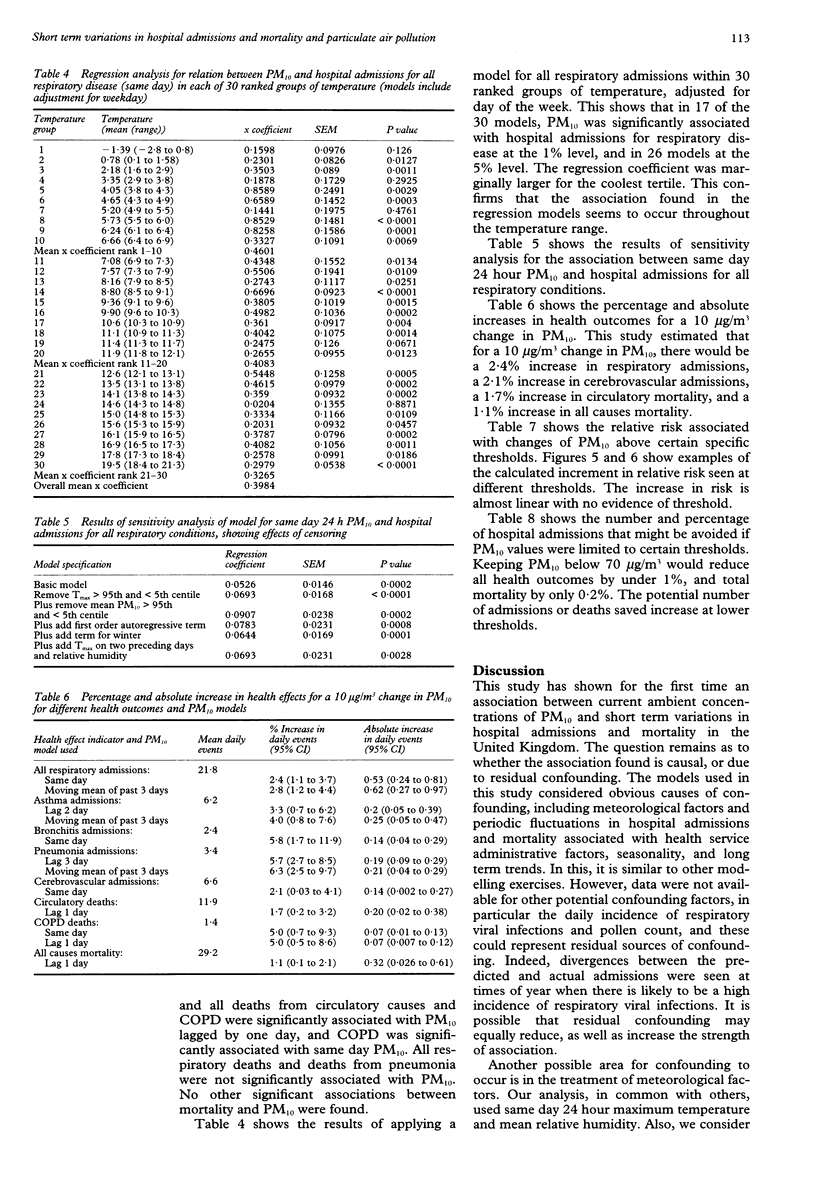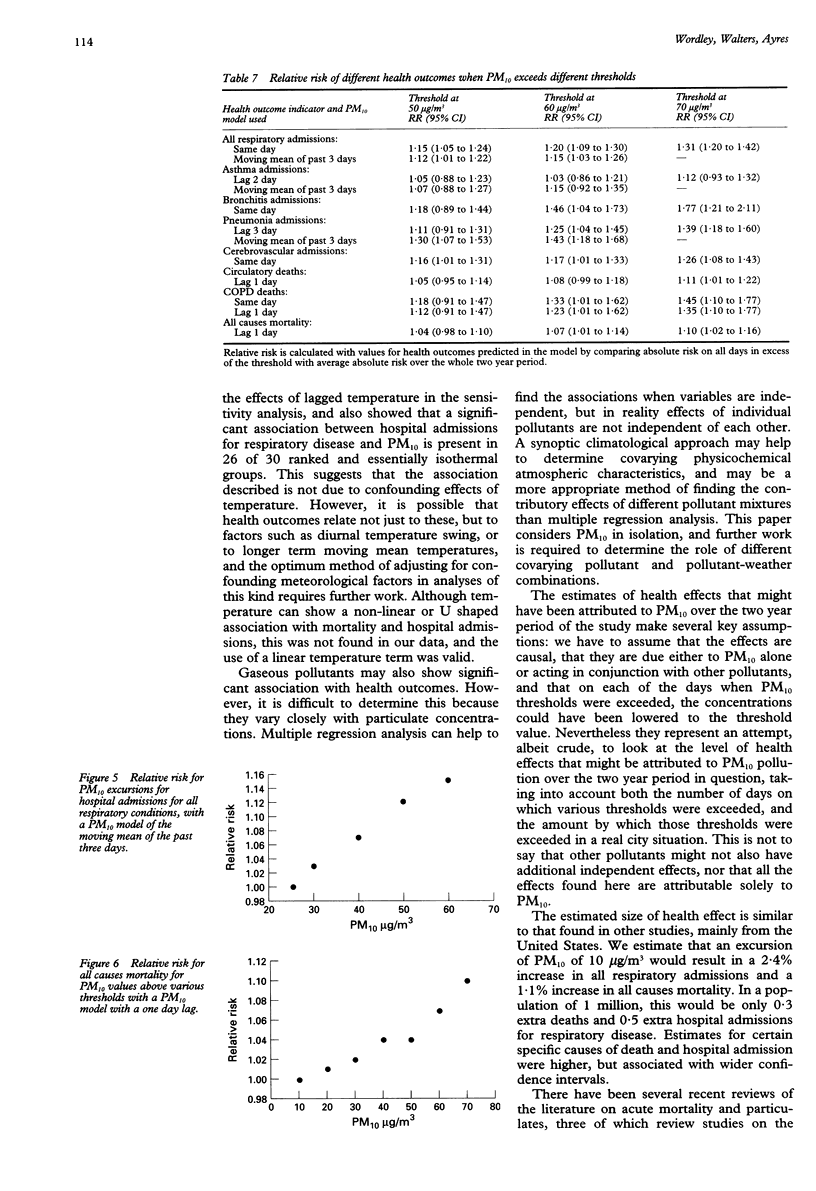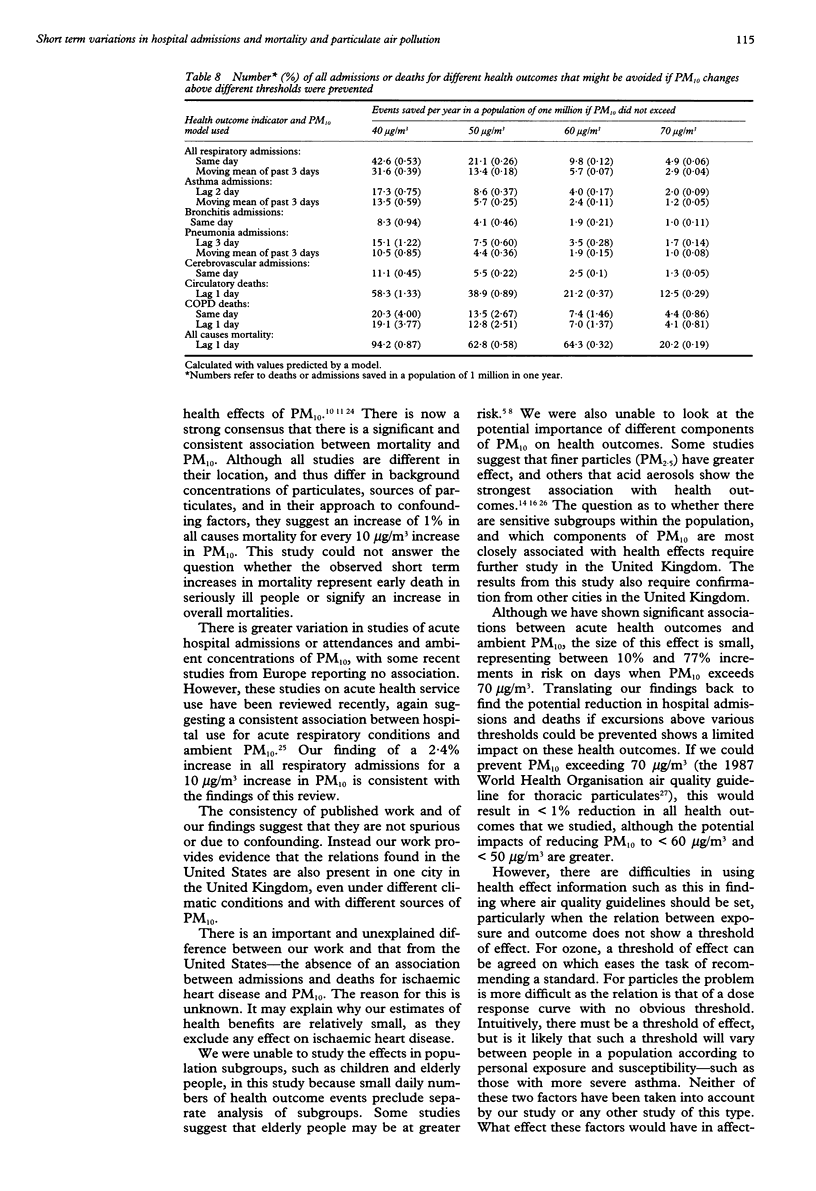Abstract
OBJECTIVES: To determine the presence and magnitude of any relation between short term variations in ambient concentrations of particulate matter under 10 microns in diameter (PM10) and hospital admissions and mortality in Birmingham, United Kingdom. To find the relative risk associated with various concentrations of PM10, and to estimate the potential public health benefit of reducing PM10 to below various thresholds. METHODS: Retrospective ecological study. Air pollution data were taken from a national network monitoring station between 1 April 1992 and 31 March 1994, and weather data for the same period from the University of Birmingham Weather Service. Daily total hospital admissions for the same period for asthma, bronchitis, pneumonia, chronic obstructive pulmonary disease (COPD), acute ischaemic heart disease, acute cerebrovascular disease, all respiratory conditions, and all circulatory conditions were obtained from the West Midlands Regional Health Authority, as well as daily total deaths from 1 April 1992 to 31 December 1994 for chronic obstructive pulmonary disease, pneumonia, all respiratory diseases, all circulatory diseases, and all causes. Multiple linear regression models were constructed after adjusting for confounding factors (day of week, month, linear trend, relative humidity, and temperature). Relative risk of admission at various thresholds of PM10 was calculated with the model, by comparing risk of admission over the threshold with mean risk of admission over the whole period. Potential public health benefits at various thresholds were calculated with the model to predict the number of admissions of deaths that could be saved if, on each day that the PM10 had exceeded that threshold, it had instead been kept at the threshold level. RESULTS: Significant associations were found between all respiratory admissions, cerebrovascular admissions, and bronchitis admissions and PM10 on the same day. Pneumonia, all respiratory admissions, and asthma admissions were significantly associated with the mean PM10 values for the past three days. Deaths from COPD, all circulatory deaths, and all causes mortality were significantly associated with PM10 24 hours previously, and COPD deaths also with PM10 on the same day. The effect of a 10 micrograms/m3 rise in PM10 was estimated to represent a 2.4% increase in respiratory admissions, a 2.1% increase in cerebrovascular admissions, and a 1.1% increase in all causes mortality. In a population of 1 million, this would represent 0.5 extra respiratory admissions and 0.3 extra deaths. The increase in relative risk was linear without evidence of a threshold. The impact of reducing PM10 to below 70 micrograms/m3 would be small, representing less than 0.1% of respiratory admissions and 0.2% all causes mortality. The impact would be greater at lower thresholds. CONCLUSION: Ambient outdoor concentrations of PM10 in the United Kingdom are significantly associated with several indicators of acute health effect. These associations are similar to and consistent with other studies. However, the estimated size of the public health effect is small, accounting for only a small proportion of hospital admissions and mortality over a two year period.
Full text
PDF








Selected References
These references are in PubMed. This may not be the complete list of references from this article.
- Anderson H. R., Ponce de Leon A., Bland J. M., Bower J. S., Strachan D. P. Air pollution and daily mortality in London: 1987-92. BMJ. 1996 Mar 16;312(7032):665–669. doi: 10.1136/bmj.312.7032.665. [DOI] [PMC free article] [PubMed] [Google Scholar]
- Dockery D. W., Schwartz J., Spengler J. D. Air pollution and daily mortality: associations with particulates and acid aerosols. Environ Res. 1992 Dec;59(2):362–373. doi: 10.1016/s0013-9351(05)80042-8. [DOI] [PubMed] [Google Scholar]
- Fairley D. The relationship of daily mortality to suspended particulates in Santa Clara County, 1980-1986. Environ Health Perspect. 1990 Nov;89:159–168. doi: 10.1289/ehp.9089159. [DOI] [PMC free article] [PubMed] [Google Scholar]
- Lipfert F. W. A critical review of studies of the association between demands for hospital services and air pollution. Environ Health Perspect. 1993 Jul;101 (Suppl 2):229–268. doi: 10.1289/ehp.93101s2229. [DOI] [PMC free article] [PubMed] [Google Scholar]
- Lipfert F. W., Hammerstrom T. Temporal patterns in air pollution and hospital admissions. Environ Res. 1992 Dec;59(2):374–399. doi: 10.1016/s0013-9351(05)80043-x. [DOI] [PubMed] [Google Scholar]
- Ostro B. The association of air pollution and mortality: examining the case for inference. Arch Environ Health. 1993 Sep-Oct;48(5):336–342. doi: 10.1080/00039896.1993.9936722. [DOI] [PubMed] [Google Scholar]
- Pope C. A., 3rd Respiratory disease associated with community air pollution and a steel mill, Utah Valley. Am J Public Health. 1989 May;79(5):623–628. doi: 10.2105/ajph.79.5.623. [DOI] [PMC free article] [PubMed] [Google Scholar]
- Pope C. A., 3rd, Schwartz J., Ransom M. R. Daily mortality and PM10 pollution in Utah Valley. Arch Environ Health. 1992 May-Jun;47(3):211–217. doi: 10.1080/00039896.1992.9938351. [DOI] [PubMed] [Google Scholar]
- Schwartz J. Particulate air pollution and daily mortality in Detroit. Environ Res. 1991 Dec;56(2):204–213. doi: 10.1016/s0013-9351(05)80009-x. [DOI] [PubMed] [Google Scholar]
- Schwartz J., Slater D., Larson T. V., Pierson W. E., Koenig J. Q. Particulate air pollution and hospital emergency room visits for asthma in Seattle. Am Rev Respir Dis. 1993 Apr;147(4):826–831. doi: 10.1164/ajrccm/147.4.826. [DOI] [PubMed] [Google Scholar]
- Thurston G. D., Ito K., Hayes C. G., Bates D. V., Lippmann M. Respiratory hospital admissions and summertime haze air pollution in Toronto, Ontario: consideration of the role of acid aerosols. Environ Res. 1994 May;65(2):271–290. doi: 10.1006/enrs.1994.1037. [DOI] [PubMed] [Google Scholar]
- Thurston G. D., Ito K., Kinney P. L., Lippmann M. A multi-year study of air pollution and respiratory hospital admissions in three New York State metropolitan areas: results for 1988 and 1989 summers. J Expo Anal Environ Epidemiol. 1992 Oct-Dec;2(4):429–450. [PubMed] [Google Scholar]
- Walters S., Griffiths R. K., Ayres J. G. Temporal association between hospital admissions for asthma in Birmingham and ambient levels of sulphur dioxide and smoke. Thorax. 1994 Feb;49(2):133–140. doi: 10.1136/thx.49.2.133. [DOI] [PMC free article] [PubMed] [Google Scholar]


